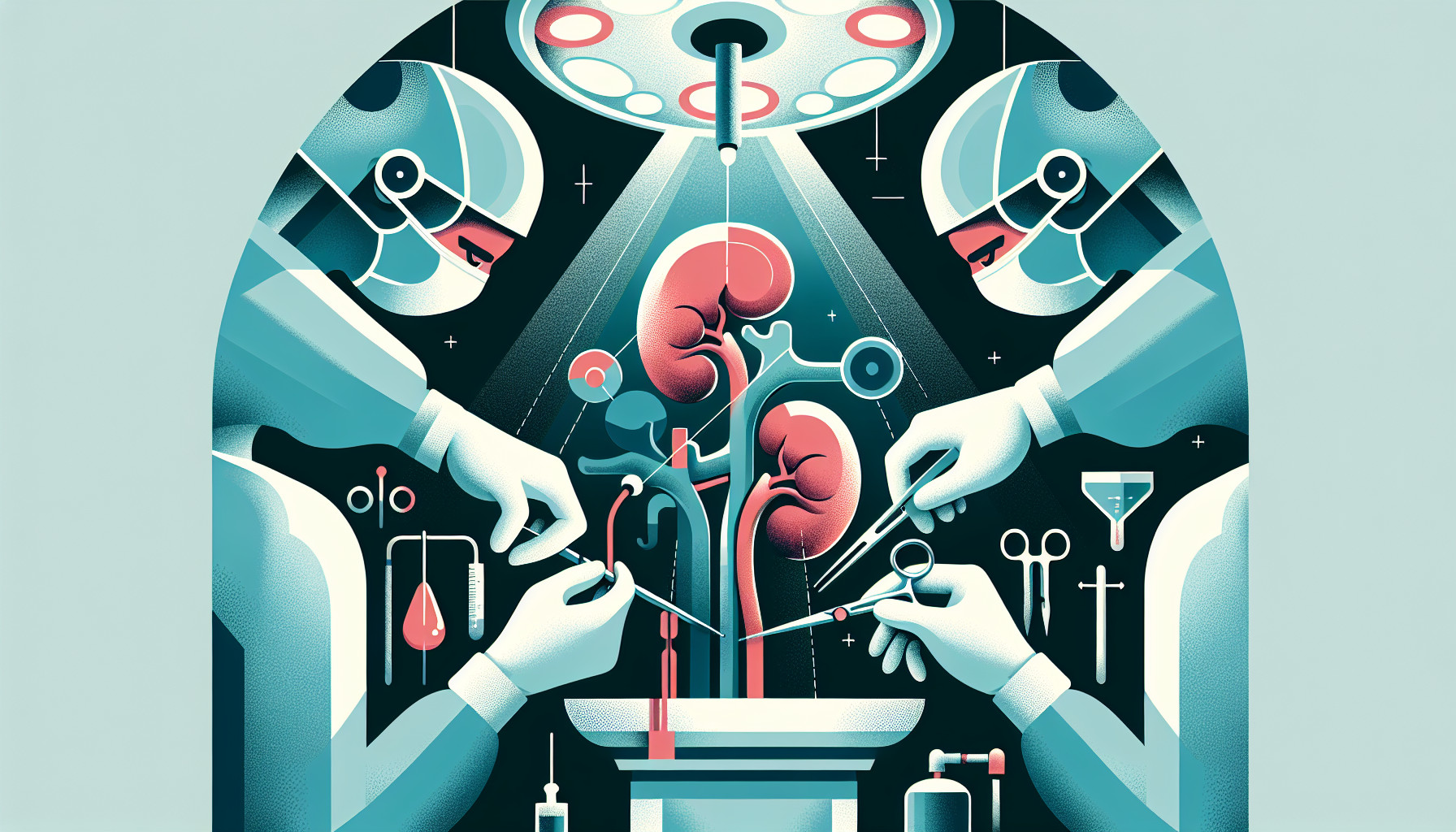Our Summary
This research paper compares two methods of kidney removal for kidney donors: laparoscopic donor nephrectomy (a minimally invasive surgical procedure using a small camera and surgical instruments) and finger-assisted open donor nephrectomy (a more traditional surgical method using hands-on manipulation).
The study analyzed data from 95 kidney donors and found that both methods had similar results in terms of donor characteristics and preferences for the kidney that was removed. However, the laparoscopic method took longer, required a longer incision, but resulted in a shorter hospital stay.
On the other hand, the finger-assisted method had fewer post-operation complications and better kidney function in donors a year after donation. Yet, the kidney recipients from both methods had similar kidney function a year after transplantation.
In conclusion, the study suggests that the finger-assisted open donor nephrectomy is a safe and successful alternative to the laparoscopic method, with fewer complications and better outcomes for the donors.
FAQs
- What are the two methods of kidney removal for kidney donors discussed in the research?
- How do the outcomes of laparoscopic donor nephrectomy and finger-assisted open donor nephrectomy compare according to the study?
- Does the choice of kidney removal method affect the kidney function in recipients a year after transplantation?
Doctor’s Tip
A helpful tip a doctor might tell a patient about laparoscopic nephrectomy is to be aware of the potential risks and benefits associated with the procedure. Patients should discuss with their doctor the specific details of the surgery, including the expected recovery time, potential complications, and expected outcomes. It is important for patients to follow their doctor’s instructions for post-operative care to ensure a smooth recovery process.
Suitable For
Typically, patients who are recommended for laparoscopic nephrectomy are those who require removal of a kidney due to conditions such as kidney cancer, kidney stones, or kidney donation for transplantation. Laparoscopic nephrectomy is particularly beneficial for patients who prefer a minimally invasive surgical approach, as it results in smaller incisions, less pain, shorter hospital stays, and faster recovery times compared to traditional open surgery. Additionally, laparoscopic nephrectomy may be recommended for patients who have preexisting health conditions that make them better candidates for a minimally invasive approach.
Timeline
Before laparoscopic nephrectomy:
- Patient is diagnosed with a condition that requires kidney removal.
- Patient discusses treatment options with their healthcare provider, including the possibility of laparoscopic nephrectomy.
- Patient undergoes pre-operative testing and evaluation to determine if they are a suitable candidate for surgery.
During laparoscopic nephrectomy:
- Patient is placed under general anesthesia.
- Surgeon makes small incisions in the abdomen and inserts a camera and surgical instruments to remove the kidney.
- The kidney is carefully detached from surrounding tissues and blood vessels.
- The kidney is then removed through one of the small incisions.
- Surgeon closes the incisions with stitches or surgical tape.
After laparoscopic nephrectomy:
- Patient is monitored in the recovery room before being transferred to a hospital room.
- Patient may experience discomfort, fatigue, and soreness at the incision sites.
- Patient is encouraged to walk and move around to aid in recovery.
- Patient is discharged from the hospital once they are stable and able to manage pain at home.
- Patient is advised on post-operative care, including wound care, pain management, and activity restrictions.
- Patient follows up with their healthcare provider for monitoring and follow-up care.
What to Ask Your Doctor
- What are the potential risks and complications associated with laparoscopic nephrectomy compared to the finger-assisted open nephrectomy method?
- How long is the recovery time expected to be for each method?
- Will I need to stay in the hospital after the procedure, and if so, for how long?
- What type of incision will be made for the laparoscopic nephrectomy, and how large will it be?
- How will the post-operative pain be managed for each method?
- What are the long-term implications for kidney function and overall health with each method?
- Are there any specific factors that would make me a better candidate for one method over the other?
- How experienced is the surgical team in performing laparoscopic nephrectomy and finger-assisted open nephrectomy procedures?
- What is the success rate of both methods in terms of kidney donation and transplantation outcomes?
- Are there any lifestyle changes or restrictions I should be aware of following the procedure with either method?
Reference
Authors: Shahbazov R, Maluf D, Azari F, Hakim D, Martin O, Dicocco P, Alejo JL, Saracino G, Hakim N. Journal: Exp Clin Transplant. 2020 Oct;18(5):585-590. doi: 10.6002/ect.2019.0115. Epub 2019 Sep 16. PMID: 31526334
